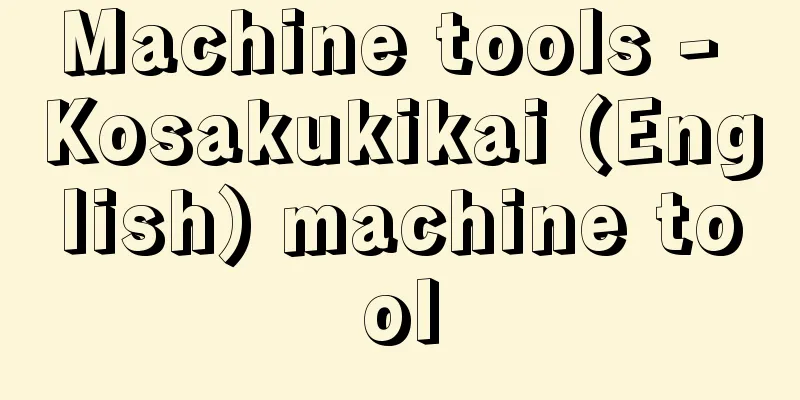Machine tools - Kosakukikai (English) machine tool

|
A machine used to process machine parts and materials made by casting, forging, rolling, etc. into finished products. It is a machine that processes metals and other materials while producing shavings through cutting and grinding, which are the basic subtractive processing methods, to create a desired shape. It has the function of combining the rotational and linear motion of the workpiece and tool to give them relative motion and create the required shape. It has long been called a "machine that makes machines," and forms the basis of the mechanical industry. Literally speaking, it also includes processing machines such as forging, rolling, pressing, and shearing, but since these do not perform subtractive processing, they are not generally called machine tools. [Hidetaro Nakayama and Shinji Shimizu] History of Machine ToolsAncient Machine ToolsMaking tea bowls from kneaded clay and carving round bars from wood have been done since ancient times, and potter's wheels, which can be considered a type of machine tool, are already depicted in Egyptian wall paintings. Potter's wheels were also used in Japan in the 7th and 8th centuries. The potter's wheel used during the construction of Todaiji Temple was a two-person wheel, with one person pulling a rope attached to the rotating shaft to turn it, and the other holding a blade to carve the wood. The wheel was eventually improved into a large wheel-type wheel, which rotates the wheel by attaching a belt to the wheel and rotating shaft, or a foot-operated wheel. Around the 13th century, simple power lathes began to be used in Europe. One end of a flexible wooden branch was fixed to the ceiling, and the other end was attached to a rope that was wound around a rotating shaft and the other end was connected to a footboard. Stepping on the footboard caused the rope to move back and forth, rotating the workpiece fixed to the rotating shaft, and the workpiece was processed by pressing a blade against it by hand. The English word "lathe" for a flexible board became the origin of the word "lathe." Later, watchmakers and other mechanical engineers, each using their own ingenuity, built their own small benchtop lathes, which became popular for carving small items. [Hidetaro Nakayama] The Beginning of Machine ToolsIn the latter half of the 18th century, the invention and improvement of spinning and weaving machines were made one after another, and the curtain was raised on the British Industrial Revolution. The progress of the Industrial Revolution was further spurred by the invention of the steam engine by James Watt. When powerful steam engines began to be used to power factories, machines had to be changed from weak wooden materials to metal ones. To make machines made of metal, mainly iron, machines that could process iron were needed. In 1797, Henry Moseley of England created a new lathe, which is the prototype of today's lathes. It was made entirely of metal with a bed length of 3 feet (about 91 centimeters) and a slide rest, and it could cut not only round bars but also threads. The cutting tool was fixed to the slide rest that moved left and right by a screw, and when the main shaft was rotated, the lead screw was rotated by a gear, and the slide rest that was meshed with the lead screw also moved. There was no need to hold the cutting tool in one's hand, and the cutting tool moved left and right automatically when the main shaft of the lathe was rotated, so there was no need to adjust it by hand. With the completion of the sliding rest lathe, machines could perform work faster and more accurately than skilled workers could, stimulating a leap in the machinery manufacturing industry. The British Industrial Revolution, which began with the improvements to spinning machines by John Wyatt and Lewis Pole and developed with the powerful power of Watt's steam engine, can be said to have been completed with the invention of the lathe by Maudsley. [Hidetaro Nakayama] The perfection of machine toolsThe cylinders for Watt's steam engines were made with John Wilkinson's boring machine. The axles driven by the engine of the Great Britain, the world's first ocean-going iron screw ship, built in 1843, were forged with Nasmyth's steam hammer. In the 1850s, Joseph Whitworth of England began manufacturing and selling a wide range of machine tools, including lathes, drill presses, planers, shaping machines, slotting machines, threading machines, and gear cutting machines. In 1818, American Eli Whitney aimed to make the parts of the muskets he was manufacturing interchangeable. To make mass-produced parts fit every gun, a highly accurate machine was needed that could produce products of the same specifications even by unskilled workers. For this purpose, the milling machine was developed, which rotates a blade (a milling cutter) and cuts out flat surfaces by moving the workpiece back and forth and side to side on a table. In 1853, the American company Robbins Lawrence also manufactured milling machines for firearms production. The first universal milling machine, manufactured in 1855 by Joseph Rogers Brown, founder of the American company Brown & Sharpe, had a major impact on subsequent machine tools. While it was possible to make interchangeable parts for the mechanism of a gun, irregular shapes such as gun stocks had to be made by hand. In 1820, American Thomas Blanchard (1788-1864) invented a machine to make wooden gun stocks of the same shape, making it possible to make completely interchangeable guns. With this machine, a friction wheel was moved along a completed gun stock, and a cutting wheel attached to the same axis moved in the same way as the friction wheel, cutting the wood piece and creating an identical gun stock. Blanchard improved this machine so that it could also make shoe and hat patterns, car spokes, etc., and further devised a pantograph that could be attached to enlarge or reduce the dimensions of the model to move the cutting wheel. This is how the tracing machine was created. In 1845, Stephen Fitch of Milford, Connecticut built a horizontal turret lathe capable of mounting eight blades on a tool rest for the production of firearms for the U.S. military. Around the same time, the turret lathe invented by Henry Stone of Robbins Lawrence Co. was also used in the factory of Samuel Colt (1814-1862). In 1870, Colt's apprentice, Christopher Miner Spencer (1833-1922), invented the automatic turret lathe. In 1864, a grinding machine was created that mechanized the process of sharpening blades with a whetstone. It was first used to finish the needles of sewing machines, with a whetstone attached to the feed table of a lathe instead of a bit. Later, in 1875, Brown & Sharpe & Co. produced an all-purpose grinding machine, and Charles Norton (1851-1942) of the same company developed the cylindrical grinding machine, widening the range of applications. [Hidetaro Nakayama] The automation eraThe number of types of machine tools increased, their performance improved, and machining accuracy improved, so most manual work was mechanized. However, manual labor was still required for things like installing materials and tools, and selecting cutting speeds and feed rates, so one worker had to be assigned to each machine tool. However, with mass production, the standardization of work progressed, and specialized machines appeared, making them easier to use and less skilled. Conveyors also came to be used to transport workpieces, and the idea of connecting several specialized machines with conveyors to further reduce the number of workers was conceived. This resulted in the transfer machine, which moves the work table (bed) of the machine tool like a conveyor. The first transfer machine was used by the Morris Motor Company in the UK for machining cylinder blocks. The bed moved to connect 53 types of machining machines, and 21 workers could machine 15 sets of cylinder blocks per hour. In 1947, the Ford Motor Company in the US developed a more improved, more powerful transfer machine. This machine, which handles everything from materials to finished product, quickly spread throughout the world and sparked the trend toward automation. [Hidetaro Nakayama] ComputerizationWith the development of electronic engineering, around 1947, John T. Parsons (1913-2007) of the United States came up with a method of controlling each axis of a machine tool by generating control pulses for each axis and creating the required contour shape. This is said to be the beginning of Numerical Control (NC). The development then moved to the Massachusetts Institute of Technology (MIT), and in 1952, the NC milling machine was completed. Initially, it was called numerical control because the machining information required for machining, such as the tool path and speed, was input into the control device as numerical information. However, recently, with the advancement of microprocessors, computer functions have been installed in NC devices, and it has become possible to generate numerical command information for machining complex workpieces by the internal calculation function by simply inputting simple command information, without having to give all commands as numerical information. Therefore, NC devices are sometimes called CNC (Computerized NC) devices. Recent NC devices are equipped with multiple microprocessors, and can machine more complex shapes with higher precision and speed. Furthermore, advances in information and communications technology have enabled the incorporation of Ethernet communication functions, making it possible to simultaneously manage a large number of machine tools, making it possible to build more advanced production systems with machine tools at their core. [Shimizu Shinji] Machine Tool TypesMachine tools, also known as machines that make machines, are used to directly or indirectly create all kinds of products that exist in the world, so their uses are wide and there are many different types of machine tools. JIS (Japanese Industrial Standards) classifies these machine tools based on the processing operations they can perform. These include lathes for turning, drill presses for drilling, boring machines for boring, milling machines for milling, grinding machines for grinding, surface finishing machines for lapping and super-finishing, gear cutting machines, planing machines, shaping machines, slotting machines, broaching machines, cutting machines (metal cutting saws), multi-function machine tools, special processing machines, and other machine tools. Each of these machine tools has a different structure, and there are many types of lathes alone, such as ordinary lathes, automatic lathes, turret lathes, face lathes, wheel lathes, and crankshaft lathes. [Shimizu Shinji] Machine tool classificationThe above machine tools are broadly classified according to the workpiece, processing function, structure, and basic specifications, and these are sometimes used as the names of the machine tools in catalogs, etc. From such classifications, it is also possible to understand the needs for which each machine tool was created. In relation to workpieces, they can be classified according to the movement and shape of the workpiece during machining. Based on the movement of the workpiece, it can be classified according to whether the workpiece rotates or not. Machines in which the workpiece rotates include lathes and cylindrical grinding machines, and the workpiece shape is often cylindrical or cylindrical rod-shaped. Machines in which the workpiece does not rotate include drill presses, milling machines, boring machines, and surface grinders. The workpiece shape is often rectangular or plate-shaped. Multi-function machine tools that can handle both cases where the workpiece rotates and cases where it does not include multi-tasking machine tools based on turning centers and machining centers. In terms of machining functions, they can be classified based on the possible machining surface shapes, the machining work mentioned above, and the machining energy. In terms of machining surface shapes, there are machines that machine the outer surface of cylinders, such as lathes and cylindrical grinders, machines that machine flat surfaces, such as milling machines and surface grinders, machines that machine holes, such as drill presses and boring machines, and machines that machine specific shaped surfaces such as tooth surfaces, such as gear cutting machines and gear grinders. Processing energy can be classified into mechanical, thermal, chemical, electrochemical, and a combination of these. Most of the machines mentioned above are mechanical, but they are classified as special processing machines. Thermal energy includes electric discharge machines and laser processing machines, chemical energy includes chemical processing machines and chemical polishing machines, and electrochemical energy includes electrochemical processing machines. In terms of structural form, they can be classified according to a combination of machine size, basic structural form, and the motion form of tools and workpieces. In terms of machine size, there are ultra-small machine tools (micro machine tools), benchtop machine tools, small machine tools, normal machine tools (usually without the normal type), large machine tools, and extra-large machine tools, and are called, for example, small lathes. In terms of basic structural form, there are various types of lathes depending on the structural form, such as the structural form of the main body (vertical, horizontal, gate type, etc.), the number of spindle heads (double-headed, multi-headed, etc.), and the number of spindles (single-axis, multi-axis, etc.). For example, they are called vertical lathes and multi-axis automatic lathes. In terms of the motion form of tools and workpieces, there are various types of lathes depending on the combination of each motion form (rotation, straight, rotation/straight, stop). In terms of basic specifications, they can be classified according to the precision of machining, productivity, control method, variety of workpieces that can be machined, etc. In terms of precision, there are (normal precision) machine tools (not specifically called normal precision), (high) precision machine tools, ultra-precision machine tools, etc. For example, they are called precision lathes and ultra-precision lathes. In terms of productivity, there are normal machine tools, high-speed machine tools, and ultra-high-speed machine tools. In terms of control methods, there are manual types, mechanical control types using cams and links, hydraulic control types, and numerical control types. 90% of machine tools produced in Japan are numerically controlled machine tools. In terms of the variety of workpieces that can be machined, there are general-purpose machine tools, single-purpose machine tools, and special-purpose machine tools. General-purpose machine tools are general-purpose machine tools that are made to be able to machine a variety of parts. Single-purpose machine tools are machines that, once set for a certain workpiece, can continue to perform the same single-purpose machining, such as automatic lathes. Special-purpose machine tools are machine tools that are limited to a specific machining target, such as crankshaft machining, cam machining, or wheel machining, such as wheel lathes. [Shimizu Shinji] "Masao Kubota, 'Machine Tools - Machines that Make Machines' (1970, Nihon Keizai Shimbun)" ▽ "Shinji Shimizu, 'Learn Machine Tools from the Basics - Understand the Common Basic Structure and Mechanism' New Edition (2011, Taiga Publishing)" ▽ "News Digest Publishing, 'My First Machine Tools' Revised 17th Edition (2012)" [References] | | | | | | | | | | | | |Boring machine| | | | |Whitworth| |Drill press| |©Shogakukan "> List of machine tool types and uses (1) ©Shogakukan "> List of machine tool types and uses (2) ©Shogakukan "> Lathe structure ©Shogakukan "> Structure of a milling machine (vertical milling machine/hi… ©Takashi Aoki Structure of a drill press (upright drill press) ©Makoto Takahashi Structure of a grinding machine (surface grinding machine) ©Shogakukan "> Structure of a boring machine (horizontal boring machine) ©Makoto Takahashi Structure of the shaper ©Shogakukan "> Structure of a vertical milling machine Source: Shogakukan Encyclopedia Nipponica About Encyclopedia Nipponica Information | Legend |
|
鋳造・鍛造・圧延などによってつくられた機械部品や素材を加工して完成品にするために使用する機械。除去加工法の基本というべき切削加工や研削加工などにより、削りくずを出しながら金属その他の材料を加工し、所定の形につくりあげる機械である。工作物と工具の回転運動や直進運動を組み合わせて、両者に相対運動を与え、必要な形状を創成する機能を有している。昔から「機械をつくる機械」といわれ、機械工業の基礎をなしている。字義からすれば、鍛造・圧延・プレス・剪断(せんだん)などの加工機械も含まれるが、それらは、除去加工を行わないので、一般には工作機械とよばない。 [中山秀太郎・清水伸二] 工作機械の歴史古代の工作機械粘土をこねて茶碗(ちゃわん)をつくったり、木から丸棒を削り出す作業は古くから行われ、すでにエジプトの壁画にも、工作機械の一種といえるろくろが描かれている。日本でも7、8世紀にはろくろが使われていた。東大寺建立のときに使用されたろくろは、回転軸に掛けた綱を引いて回す人と、刃物を持って木を削る人とが作業する二人びきろくろであった。ろくろはやがて車輪と回転軸にベルトを掛けて回転させる大車仕掛けろくろ、あるいは足踏み式ろくろへと改良された。 13世紀を過ぎるころ、ヨーロッパで簡単な動力旋盤が使われるようになった。天井にたわみやすい木の枝の一端を固定し、他の端につけた綱を回転軸に巻き付けて綱の先を踏み板につなぐ。踏み板を踏むことで綱は往復運動をし、回転軸に固定した加工物を回転させ、刃物を手で押し付けて加工するのである。たわみ板の英語lathが旋盤latheの語源となった。 その後、時計師をはじめとする機械技術者たちが、それぞれ独自のくふうをして小形の卓上用旋盤を自作し、小物の細工用として普及するようになった。 [中山秀太郎] 工作機械の幕開き18世紀の後半、紡績機械・織物機械などの発明や改良が相次いで行われ、イギリス産業革命の幕が開かれた。ジェームズ・ワットによる蒸気機関の発明によって産業革命の進行はさらに拍車をかけられた。強力な蒸気機関が工場の動力として使用されるようになると、機械は強度の弱い木製から金属製へと変わらざるをえない。金属製、おもに鉄製の機械をつくるには鉄を加工する機械が必要である。1797年、イギリスのヘンリー・モーズリーは、今日の旋盤の原型となる新しい旋盤を製作した。ベッドの長さ3フィート(約91センチメートル)、スライドレスト(送り台)付きの全金属製で、丸棒だけでなくねじを切ることもできた。刃物はねじによって左右に動くスライドレストに固定され、主軸を回転させると歯車によって親ねじが回り、親ねじにかみ合っているスライドレストも動くようになっている。刃物を手で持つ必要がなく、旋盤の主軸を回転させれば刃物は自動的に左右に動くので、手による加減の必要がない。スライドレスト付き旋盤の完成で、機械が熟練工の手よりも早く正確に仕事をするようになり、機械製造事業の飛躍が促進された。ジョン・ワイアットとルイス・ポールの紡績機械の改良に始まり、ワットの蒸気機関の強力な動力で発展したイギリスの産業革命は、モーズリーの旋盤の発明で完成されたといってもよい。 [中山秀太郎] 工作機械の完成期ワットの蒸気機関のシリンダーはジョン・ウィルキンソンの中ぐり盤でつくられた。1843年に建造された世界最初の外航鉄製スクリュー船グレート・ブリテン号のエンジンで駆動される車軸はナスミスの蒸気ハンマーで鍛造された。1850年代になるとイギリスのジョセフ・ホイットワースは、旋盤、ボール盤、平削り盤、形削り盤、立て削り盤、ねじ切り、歯切盤など多種類の工作機械の製造販売を開始した。 1818年アメリカのイーライ・ホイットニーは、製造を引き受けたマスケット銃の部品に互換性をもたせることを企図した。大量生産の部品がどの銃にもあうためには、熟練労働者でなくても同じ規格の製品がつくれる精度の高い機械が必要である。刃物(フライス)を回転させ、被加工物をテーブルの上で前後左右に動かしながら平面を削り出すフライス盤がそのために開発された。1853年にはアメリカのロビンス・ローレンス社でも銃器生産用としてフライス盤を製作している。1855年にアメリカのブラウン・シャープ社の創立者ジョゼフ・ロジャーズ・ブラウンが製造した最初の万能フライス盤は、その後の工作機械に大きな影響を与えた。 銃の機構部分は互換性のある部品を製作できたが、銃床のような不規則な形は手作業であった。1820年に、アメリカのブランチャードThomas Blanchard(1788―1864)が同じ形の木製の銃床をつくる機械を発明し、完全に互換性のある銃が製作できるようになった。この機械は、摩擦車を、できあがっている銃床に沿って動かすと、同一軸に取り付けられた切削車が摩擦車と同じ動きをして木片を切削してゆき、同型の銃床をつくりだした。ブランチャードはこの機械を靴や帽子の型、車のスポークなども製作できるように改良し、さらにパンタグラフをつけて、模型の寸法を拡大・縮小して切削車を動かすようにくふうした。こうしてならい盤がつくられたのである。 1845年、コネティカット州ミルフォードのフィッチStephen Fitchは、アメリカ軍の銃器製作用として、刃物台に8個の刃物を取り付けることのできる横型のタレット旋盤を製作した。同じころ、アメリカのコルトSamuel Colt(1814―1862)の工場でもロビンス・ローレンス社のストーンHenry Stoneが考案したタレット旋盤が使われだした。1870年には、コルトの弟子のスペンサーChristopher Miner Spencer(1833―1922)が自動タレット旋盤を発明した。 1864年、砥石で刃物を研ぐ作業を機械化した研削盤がつくられた。最初はミシンに使用する針の仕上げ用として、旋盤の送り台にバイトのかわりに砥石を取り付けて使用されていた。その後1875年に、ブラウン・シャープ社が万能研削盤を製作、さらに同社のノートンCharles Norton(1851―1942)が円筒研削盤を開発し応用範囲を広めた。 [中山秀太郎] 自動化時代工作機械の種類が増加し、性能も向上して加工精度もよくなり、手作業のほとんどが機械化された。しかし、材料や工具の取付け、切削速度や送りの選定などには人手が必要で、工作機械1台に作業員1人を配置しなければならなかった。だが、大量生産とともに作業の単一化が進み、専用機械も出現して取扱いが簡単になり、熟練度があまり必要でなくなった。加工物の運搬にもコンベヤーが使われるようになり、いくつかの専用機をコンベヤーで結び付けて、さらに人手を省くことが発想された。その結果登場したのが、工作機械の作業台(ベッド)をコンベヤーのように移動させるトランスファーマシンである。最初のトランスファーマシンはシリンダー・ブロック加工用に、イギリスのモーリス自動車会社で使用された。加工機械53種をつないでベッドが移動し、21人の作業員が1時間に15組のシリンダー・ブロックを加工することができた。1947年、アメリカのフォード自動車会社は、さらに改良を加えた高性能のトランスファーマシンを開発した。素材から完成までを一貫して行うこの機械は急速に世界中に広まり、オートメーションのきっかけをつくった。 [中山秀太郎] コンピュータリゼーション電子工学の発達に伴い、1947年ごろ、アメリカのパーソンズJohn T. Parsons(1913―2007)により、各軸に制御パルスを発生させ、必要な輪郭形状をつくりだすことにより工作機械の各軸を制御する方法が考案された。これが、数値制御(Numerical Control:NC)の始まりといわれている。その後、開発の舞台は、マサチューセッツ工科大学(MIT)に移り、1952年にNCフライス盤として完成した。当初は、加工のために必要な工具の経路や速度などの加工情報を数値情報として、制御装置に入力していたことから、数値制御とよばれた。しかしながら、最近では、マイクロプロセッサーの進歩とともにNC装置にコンピュータ機能が搭載されるようになり、すべての指令を数値情報として与えなくても、簡単な指令情報を入力するだけで、内部の演算機能により複雑な工作物を加工するための数値指令情報を発生できるようになった。そこで、NC装置のことをCNC(Computerized NC)装置とよぶこともある。最近のNC装置は、複数のマイクロプロセッサーを搭載しており、より複雑形状の加工を、より高精度で高速に行えるようになっている。さらに、情報通信技術の進展によりイーサネット通信機能が組み込まれ、多数の工作機械を同時に管理することができるため、工作機械を核として、より高度な生産システムが構築可能になっている。 [清水伸二] 工作機械の種類工作機械は、機械をつくる機械ともよばれ、世の中に存在するあらゆる製品を直接的、あるいは間接的につくりだすため、その用途は広く、各種各様の工作機械が存在している。JIS(日本工業規格)では、これら工作機械を可能な加工作業を基に分類している。これらには、旋削加工作業を行う旋盤、穴あけ加工作業を行うボール盤、中ぐり加工作業を行う中ぐり盤、フライス加工作業を行うフライス盤、研削加工作業を行う研削盤、ラッピングや超仕上げのように表面仕上げを行う表面仕上げ機械をはじめとして、歯切盤および歯車仕上げ機械、平削り盤・形削り盤・立て削り盤、ブローチ盤、切断機(金切鋸盤)、多機能工作機械、特殊加工機械、その他の工作機械などがある。これら各工作機械には、それぞれ構造形態の異なるものが存在し、たとえば、旋盤だけでも、普通旋盤、自動旋盤、タレット旋盤、正面旋盤、車輪旋盤、クランク軸旋盤などと、多数のものが存在している。 [清水伸二] 工作機械の分類以上のような工作機械は、大きくは、工作物関連、加工機能関連、構造形態関連、基本仕様関連をもとに分類され、カタログなどで工作機械の名称として使われることもある。このような分類から、各工作機械がどのような必要性から生まれてきたものかなども理解できる。 工作物関連では、加工時の工作物の運動と形状により分類できる。工作物の運動からは、工作物が回転するかしないかで分類できる。工作物が回転する機械としては、旋盤、円筒研削盤などがあり、工作物形状は、円筒状あるいは、円筒棒状のものが多い。工作物が回転しない機械としては、ボール盤、フライス盤、中ぐり盤、平面研削盤などがある。工作物形状は、直方体、板状のものが多い。工作物が回転する場合と、しない場合の両者に対応できるものとして、多機能工作機械であるターニングセンターやマシニングセンターを基本とした複合加工工作機械があげられる。 加工機能関連としては、可能な加工面形状、先にあげた加工作業、加工エネルギーからの分類が可能である。加工面形状としては、旋盤、円筒研削盤のように円筒外面を加工する機械、フライス盤、平面研削盤のように平面を加工する機械、ボール盤や中ぐり盤のように穴を加工する機械、歯切盤や歯車研削盤などのように歯面などの特定形状面を加工する機械がある。 加工エネルギーとしては、機械的、熱的、化学的、電気化学的、それらを複合化したものに分類できる。前述の機械は、ほとんど機械的なものであるが、特殊加工機に分類される。熱的なものとして、放電加工機、レーザー加工機など、化学的なものとして、化学加工機や化学研磨加工機など、電気化学的なものとして電解加工機などが存在している。 構造形態関連としては、機械のサイズ、基本構造形態、工具・工作物の運動形態の組合せによる分類が可能である。機械のサイズとしては、超小形工作機械(マイクロ工作機械)、卓上工作機械、小形工作機械、普通形工作機械(通常は、普通形をつけない)、大形工作機械、超大形工作機械などがあり、たとえば、小形旋盤などとよぶ。基本構造形態としては、立て形、横形、門形などの本体の構造形態、双頭、多頭などの主軸頭の数、単軸、多軸など、主軸の数など、同じ旋盤でも、構造形態により、各種のものが存在している。たとえば、立て旋盤、多軸自動盤などとよぶ。工具・工作物の運動形態では、同じ機械でも、回転、直進、回転/直進、停止という各運動形態の組合せにより、各種のものが存在している。 基本仕様関連としては、加工可能精度、生産性、制御方式、加工可能な工作物の多様性などにより、分類が可能である。精度からは、(普通精度)工作機械(とくに普通精度とはいわない)、(高)精密工作機械、超精密工作機械等が存在している。たとえば、精密旋盤、超精密旋盤などとよばれる。 生産性としては、普通工作機械、高速工作機械、超高速工作機械などが存在している。制御方式では、手動式、カムやリンクによる機械制御式、油圧制御式、数値制御式などがある。日本で生産される工作機械の9割が数値制御工作機械となっている。 加工可能な工作物の多様性としては、汎用工作機械、単能工作機械、専用工作機械などが存在している。汎用工作機械は、多様な部品加工に対応可能なようにつくられている一般の工作機械である。単能工作機械は、一度機械をある工作物用にセットすると、単能的に同じ加工を継続して行える機械で自動旋盤(自動盤)がこれにあたる。専用工作機械は、機械自体がクランク軸加工用、カム加工用、車輪加工用とその加工対象が限定されている工作機械で、車輪旋盤などが、それにあたる。 [清水伸二] 『窪田雅男著『工作機械――機械をつくる機械』(1970・日本経済新聞社)』▽『清水伸二著『初歩から学ぶ工作機械――共通な基本構造と仕組みがわかる』新版(2011・大河出版)』▽『ニュースダイジェスト社編・刊『はじめての工作機械』改訂17版(2012)』 [参照項目] | | | | | | | | | | | | | | | | | | | | | | | | | |©Shogakukan"> 工作機械の種類と用途一覧(1) ©Shogakukan"> 工作機械の種類と用途一覧(2) ©Shogakukan"> 旋盤の構造 ©Shogakukan"> フライス盤の構造(立て形フライス盤/ひ… ©青木 隆"> ボール盤の構造(直立ボール盤) ©高橋 真"> 研削盤の構造(平面研削盤) ©Shogakukan"> 中ぐり盤の構造(横中ぐり盤) ©高橋 真"> 形削り盤の構造 ©Shogakukan"> 立て削り盤の構造 出典 小学館 日本大百科全書(ニッポニカ)日本大百科全書(ニッポニカ)について 情報 | 凡例 |
Recommend
Sassoon, V. (English spelling) Sassoon V
...A prominent British Jewish family whose founde...
Wet mat
…Usually, a material called a stencil paper is pl...
Pot-au-feu
It means "a pot on fire" in French. It i...
Luxembourg compromise
…the collective name for the three supranational ...
Baillarger, J.
...It was the German psychiatrist Kraepelin who m...
Divan-ı hümayun (English spelling) divanihumayun
On the other hand, the Islamic state of the Ottom...
Malus baccata (English spelling)
… [Mitsuru Hotta]... From [Zumi] …[Yamanaka Futos...
Kadobi
〘Noun〙① A fire lit in front of the gate when seein...
Church, W.
… The development of steam cars then shifted from...
Body belay
… In a group of two or three climbers, to avoid t...
Hand of Glory
...However, there have been many stories of heali...
Economic statistics
It can be used as a general term for quantitative...
Clothes rack folding screen - Ikou byobu
...This custom has continued into early modern an...
Kuya Korea - Kuya Korea
The name of the country appears in the Gishiwajind...
Semisulcospira reinia (English spelling) Semisulcospirareinia
…Haikyuchuu [Namibe Tadashige]. . . *Some of the ...

![Sera [town] - Sera](/upload/images/67cc06bae05a0.webp)







